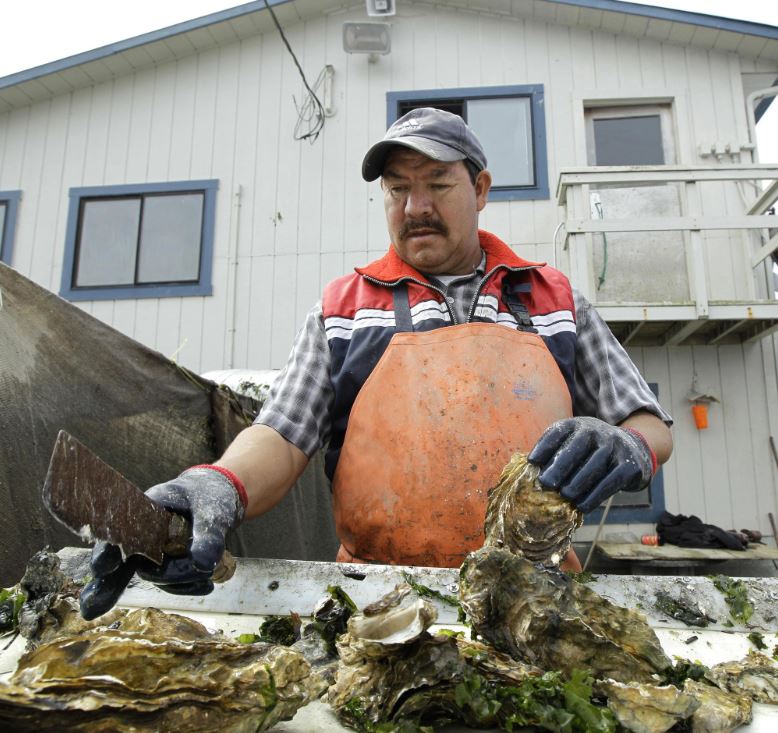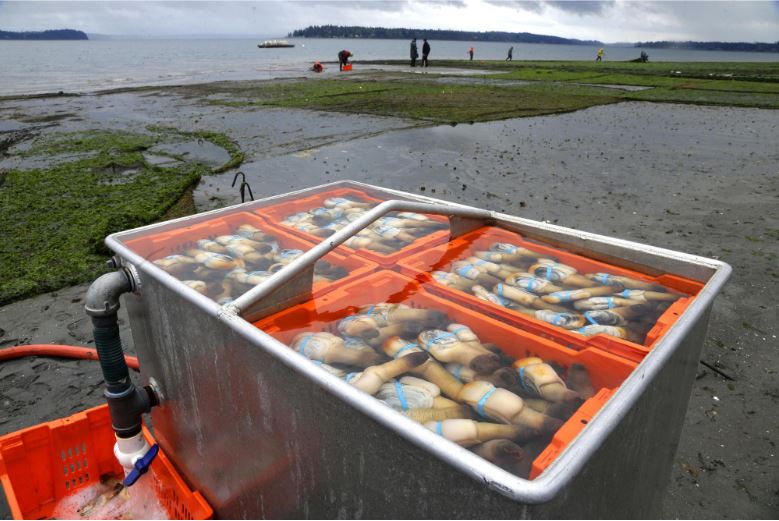Jim Freeland stands in a copse of evergreens on Vashon Island. The 150-foot trees loom as he looks up, then down into something also beautiful to him: the thousand-gallon septic tank of the client he’s about to offer counsel on off-grid waste management. “I found my calling,” says Freeland, a semiretired septic system consultant who prefers to go by Uncle Buddy or The Shit Whisperer, over the phone. For most of us, though, septic system tanks and drain fields don’t inspire a sense of the divine. But ignoring the poop passageways beneath our feet is something people in the Puget Sound region can’t afford to do. “Human sewage and also animal waste are the largest vectors for pollution that impact shellfish around the Puget Sound region and in some areas of Puget Sound,” says Mindy Roberts , Puget Sound program director of the Washington Environmental Council. These creatures are already facing ocean acidification and warming waters that force huge die-offs, like that during the June 2021 heatwave.
It’s for that reason Puget Sound Partnership, in its annual State of the Sound report, tracks septic system inventory, inspection, and repair in designated high-risk areas. The report dives into progress across dozens of key indicators — known as “vital signs” — of the estuary’s health. While septic system maintenance work hasn’t quite reached levels the partnership aimed for by 2020, it’s among 11 of 52 “ vital sign ” indicators listed as trending positively — a silver lining in a report filled with slow progress made slower in a pandemic year. Well-maintained septic systems can be low-impact ways to manage an inevitability of life, says Jeremy Simmons, wastewater section manager in the Washington Department of Health’s Office of Environmental Health and Safety. When septic systems fail, untreated human waste and all of its nutrients, bacteria ( specifically fecal coliform ), viruses, and pharmaceuticals flow not only into unsuspecting people’s homes but also into the fragile Puget Sound ecosystem. The hazardous cocktail threatens re-creation and bioaccumulates in shellfish that serve a $107 million industry and sustain Indigenous communities already facing the brunt of climate crisis impacts. Many of these systems abut shorelines, where failures can result in direct, unfiltered influxes into the sound and threaten human health.
According to the Environmental Protection Agency, the Salish Sea is a leading North American producer of shellfish, harvested both commercially and recreationally for plates around the world. In addition to climate change, regional development and the attending infrastructure we use to handle waste affect the makeup of shellfish, including clams, geoduck, mussels, and oysters. As filter feeders that consume indiscriminately whatever washes over their beds, shellfish are liable to siphon metals, waste-borne viruses and prescription drugs and other damaging pollutants into their soft tissue and even their shells. That puts whoever is unlucky enough to consume them in the path of disease and poisoning. While nutrient overload can cause algal blooms that throw aquatic ecosystems out of whack, the concern about fecal matter mainly relates to people eating tainted shellfish. “Shellfish are pretty hardy little beasts. And as long as there isn’t specific chemicals killing them, or sediments smothering them, they’re probably going to survive,” says Dr. Sheri Tonn , a professor emeritus of chemistry at Pacific Lutheran University and co-founder of Communities for a Healthy Bay. New financial resources for repairing costly septic systems and efforts to track down incompletely documented septic infrastructure have helped the region continue to make progress. But there’s a lot of room for growth — both in how we maintain septic systems and how they are monitored. As climate change leads to heavy precipitation, sea-level rise, and flooding, and as population booms and development increases stress on waste systems, environmental groups and government agencies are keeping a close eye on septic systems.
Is septic monitoring on track?
Puget Sound has made the most progress in identifying where septic systems are, with room to improve inspections and repairs. Puget Sound Partnership’s 2020 goal, set in 2011, was for the 12 public health systems in the region to finish inventorying on-site sewage systems in specially designated areas, to be current with 95% of inspections, and to fix all system failures. The designated areas covered by the report include those close to potential or threatened shellfish harvesting sites, including marine recovery areas and shellfish protection districts — not all septic systems in the region. A Puget Sound Partnership draft technical memo from 2011 also set a goal of a 10,80-acre net increase in harvestable shellfish area.

Wash. The area has had a history of too much pollution from animal and human waste getting into Samish Bay, leading to shellfish harvesting closures. (AP Photo/Ted S. Warren) In this June 17, 2011 photo, Jaime Salazar sorts freshly harvested oysters, at the Blau Oyster Co. Inc., on Samish Island, Wash. The area has had a history of too much pollution from animal and human waste getting into Samish Bay, leading to shellfish harvesting closures. (AP Photo/Ted S. Warren) “We didn’t have the data to scientifically ground these targets, but there was a desire to be ambitious,” says Simmons, who reports data for this septic system monitoring vital signs.
Simmons says it’s difficult to say just how much of the year-over-year decrease in inspection and repair rates is attributable to the pandemic, but the pandemic likely made things worse, including less outreach, education and follow-up. Four counties — Kitsap, Mason, San Juan and Whatcom —weren’t even able to provide data, in large part because of their pandemic responsibilities. That likely skewed the overall results. During the pandemic, when more people were using their home septic systems more often, the counties also reported huge jumps in maintenance requests, just as other home improvement projects increased while so many people stayed home. “We have already exceeded that number in 2021. So it’s been a significant increase,” she says.
Fecal pollution solutions
One of the reasons it’s hard to make progress in septic repairs is that they’re expensive. In 2014, the Health Department’s septic financial advisory committee identified a few barriers: the sheer expense of repairs and monitoring for homeowners
and counties alike, and a lack of political and cultural will to create more resources. They found owners needed access to loans, and health jurisdictions need more and stabler funding. Some homeowners would rather take a penalty than suffer the costs of fixing or replacing a septic system. “I think there’s also a number of people that sort of, don’t quite trust that the rules make a lot of sense, and they’re sort of on the fence about, you know, is this actually important for you to do,” Simmons says.

In this March 23, 2015, file photo, full-size geoduck clams are kept fresh in seawater before being transported for Taylor Shellfish Farms near Harstine Island. (Ted S. Warren/AP file) In this March 23, 2015, file photo, full-size geoduck clams are kept fresh in seawater before being transported for Taylor Shellfish Farms near Harstine Island. (Ted S. Warren/AP file) According to the state Department of Ecology, the average cost of a septic repair project is $24,000, with projects near sensitive waters costing more. “Many homeowners aren’t budgeting for a septic system among other routine expenses, so in addition to a money issue, it also creates a sense of fear,” says Ecology’s Seth Elsen, an environmental planner in the department’s water quality program. But preventive maintenance often ends up being cheaper than repair over the long term.
Recognizing that costs are a hurdle, counties and the state have been developing partnerships to help people pay for maintenance and repair. Regional groups like the King Conservation District offer rebates for inspections and pumping in high-risk areas. Since mid- 2016, lender Craft3 ’s partnership with local health systems has injected 1,113 septic projects with $28 million in Puget Sound counties. That’s more than twice the financing from 2007 through mid-2016. Lingering hurdles It’s hard to say just how big of an impact septic systems have on sound. But gathering that data in areas even beyond the regions included in the report could add fuel to the fire of fixing it. Septic inventorying in King County shows the region could be facing increased maintenance costs — or increased failures. Most septic systems in King County, the most populous county in the region, have an average lifespan of about 35 years, depending on how well they are maintained, Jackson says. A recent King County review of assessors’ information helped the county estimate 85,000 septic systems in its jurisdiction, of which 55,000 — two-thirds — are more than 30 years old. About 10% of all waste in King County is managed through septic systems. “Those systems are going to have increased need for maintenance, repair, and replacements,” Jackson says. There are new treatment technologies making it possible to reduce failures in older systems, she says, but they’re more complicated and require more attention. With anticipated increases in inspection and repair, people like Simmons think about how they will get enough funding and people to keep up with maintenance and inspections. “We just don’t have enough people to get this thing much further along,” he says. Correction: On Monday, December 6 at 10:36 a.m., the name of King Conservation District was amended.
Hannah Weinberger
Hannah Weinberger is a reporter at Crosscut focused on science and the environment.
Reach her on Twitter @weinbergrrrrr and email at hannah.weinberger@crosscut.com
